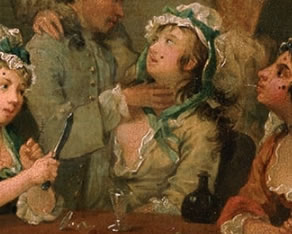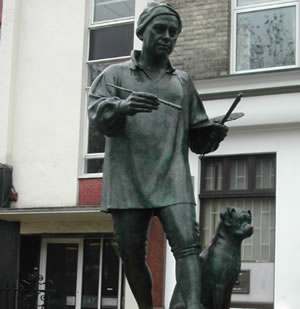Major Exhibition Of William Hogarth's Work Announced
Bringing together his paintings depicting life in 18th century London

|
The paintings of William Hogarth are to be brought together for the first time in a special exhibition at Sir John Soane's Museum.
Hogarth: Place and Progress, an exhibition of 50 or so works in which Hogarth observed the morals of contemporary 18th century life, from tragedy to comedy and biting political satire, will open next October in Sir John Soane's museum near Holborn.
Known as the father of today’s cartoons for works such as his 1751 print Gin Lane, the exhibition will be of interest locally in W4 due to Hogarth's close connections with Chiswick. All of Hogarth's surviving painted series will be united for the first time to examine his complex views on morality, the society and the city.
The darkly satirical series of William Hogarth (1697-1764) have an enduring appeal today. Cutting through social conventions, they present with wit and humour the immorality and vice that Hogarth perceived in all classes of society.

Hogarth and his pug statue in Chiswick
Hogarth: Place and Progress will unite all of Hogarth's surviving painted series for the first time, along with his engraved series. The Museum’s own Rake’s Progress and An Election will be joined by Marriage A-la-Mode from the National Gallery, the Four Times of Day from the National Trust and a private collection, as well as the three surviving paintings of The Happy Marriage from Tate and the Royal Cornwall Museum. The exhibition will also include engraved series lent by Andrew Edmunds prints such as The Four Stages of Cruelty, Industry and Idleness and Gin Lane and Beer Street.
Hogarth's narratives present a satirical take on the idea of 'progress'. The principal characters flout conventional morality and so progress not towards spiritual enlightenment but to poverty, madness and death. London settings, still identifiable today, play a key role in these cautionary tales: in A Rake’s Progress, the Rake's initial progression from the mercantile City of London to an extravagant West End mansion spirals to a brothel in Covent Garden, then ultimately to insanity and death in Bedlam madhouse, as a consequence of his dissolute lifestyle.
Displayed across the 18th century backdrop of Sir John Soane’s Museum, the exhibition will demonstrate how Hogarth’s ‘Modern Moral Subjects’ married the idea of progress with the moral geography of London, in a dynamic and evolving way throughout his own progress as an artist.
David Bindman, a leading Hogarth scholar who is curating the exhibition, said Hogarth had long been perceived as a radical social critic and champion of the lower classes, but that this exhibition would present a more complex relationship with privilege and poverty.
In an interview with The Guardian, he commented: “He was a social critic but he wasn’t against the establishment or in any way politically radical. The paintings are often seen as an attack on pretension and the aristocracy. It’s not actually the case. He had a lot of friends who were aristocrats. He simply picked up on contemporary literary ideas that the aristocracy and the merchant class had a number of people who didn’t live up to their ideals. "
The National Gallery is lending Marriage A-la-Mode, a series of six paintings about marriage and morals. Other loans include The Four Times of Day from two National Trust houses, and the three surviving paintings of The Happy Marriage – an unfinished series – from the Tate and the Royal Cornwall Museum, as well as the prints Beer Street and Gin Lane depicting the dangers of stong spirits.
Hogarth: Place and Progress will run from 9 October until 5 January
March 8, 2019